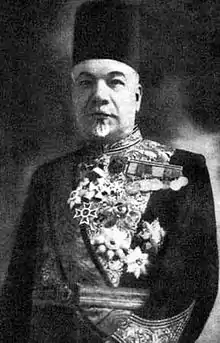Mohammed Ali Bey al-Abed
Mohammad Ali al-Abed (Arabic: محمد علي العابد / ALA-LC: Muḥammad ‘Alī al-‘Ābid; 1867–1939), also known as Mehmed Ali Bey,[1] was appointed the first president of Syria (from 11 June 1932 until 21 December 1936) as a nominee of the nationalist Syrian parliament in Damascus after the country received partial recognition of sovereignty from France. France agreed to recognize Syria as a nation under intense nationalist pressure but did not withdraw its troops completely until 1946.
Mohammad Ali al-Abed محمد علي العابد | |
|---|---|
 | |
| Head of State of Syria | |
| In office 11 June 1932 – 21 December 1936 | |
| Preceded by | Taj al-Din al-Hasani |
| Succeeded by | Hashim Al-Atassi |
| Ambassador of the Ottoman Empire to the United States | |
| In office 1906–1908 | |
| Personal details | |
| Born | 1867 Damascus, Syria Vilayet, Ottoman Empire |
| Died | 1939 (aged 72) Paris, France |
| Political party | National Bloc |
| Spouse(s) | Zahra Al-Yusuf |
Father
His father, Ahmad Izzat Pasha al-Abed, was born in Damascus to a rich family, where he was initially brought up, before pursuing his education in Beirut, Beirut Vilayet. He was fluent in Arabic, French, and Turkish. He traveled to Constantinople (now Istanbul) and served Sultan ‘Abdu’l-Hamid II of the Ottoman Empire, then became his adviser and served as the head of his intelligence services, and he also governed over the Iraqi city of Mosul. He left the Ottoman Empire in 1908 when the Young Turks revolted against Abdu'l-Hamid II and went to London, before traveling around England, Switzerland, and France. Eventually, he moved to Paris and then he moved to Egypt until his death in 1924.
Education
Mohammad Ali al-Abed was born and grew up in Damascus, where he was educated in its primary schools, then continued his education in Beirut. When he graduated, he moved with his family to Constantinople where he was sent to Galatasaray High School, a prestigious Ottoman high school. He then studied law in Paris, France. After graduation, he studied Islamic jurisprudence.
Biography
In 1908, he became the Ottoman Empire's ambassador to Washington. However, he returned to the Ottoman Empire after the declaration of the Ottoman Empire's constitution on 23 July 1908, and after his father escaped from Constantinople. He also traveled to California, United States. Then he joined his father traveling between England, Switzerland, France, and reached Egypt on the eve World War I. They remained there until his father's death.
Mohammad al-Abed moved back to Damascus in the summer of 1920 when Syria came under the French Mandate. In 1922, Al-Abed was appointed Syria's Minister of Finance.
Al-Abed was fluent in Arabic, French, and Turkish. He was fond of French literature and economics. He also had a good knowledge of English and Persian.
On 30 April 1932 Al-Abed was elected to the parliament in Damascus as a nominee of the National Bloc ( Syria ) and then elevated to the presidency on 11 June of the same year. In 1936, after a free parliament was elected in Damascus, he resigned and went to Paris, where he died in 1939. He was replaced by Mr.Hashim al-Atassi, the nominee of the National Bloc, though Syria remained in control militarily until full independence in 1946.
References
- Kuneralp, Sinan. "Ottoman Diplomatic and Consular Personnel in the United States of America, 1867-1917." In: Criss, Nur Bilge, Selçuk Esenbel, Tony Greenwood, and Louis Mazzari (editors). American Turkish Encounters: Politics and Culture, 1830-1989 (EBSCO Ebook Academic Collection). Cambridge Scholars Publishing, 12 July 2011. ISBN 144383260X, 9781443832601. pp. 100-108. CITED: p. 102. "As for Mehmed Ali Bey, he was of course recalled after the proclamation of the Constitution in July 1908 and went on to become independent Syria's president."
External links
- (in Arabic) Mohammad Ali al-Abed
